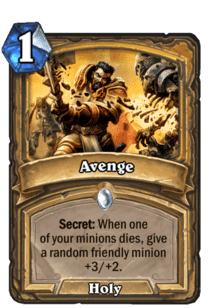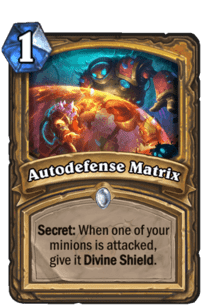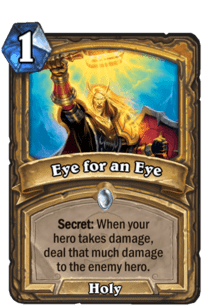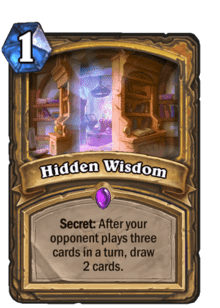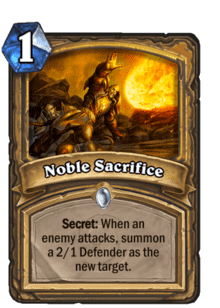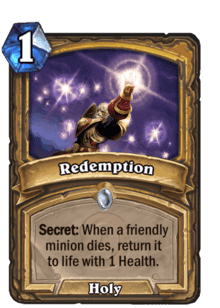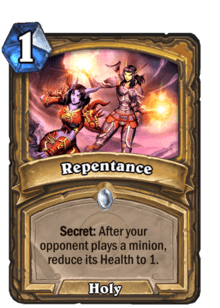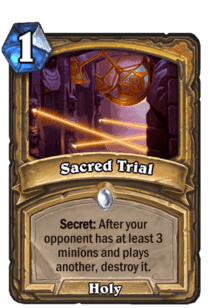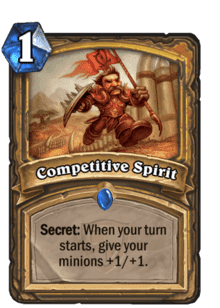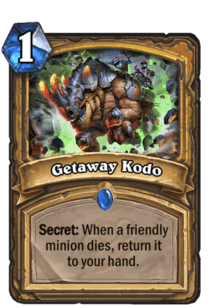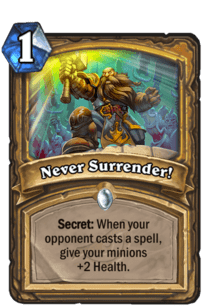Paladin Secrets
Table of Contents
Secrets are spells that, when played, place a buff on the casting hero. This buff remains active until a specific action occurs, at which point the Secret is triggered, causing its effect, and being consumed.
While your opponent can see when you play a Secret (the question mark icon that appears next to your hero's portrait will be visible to them as well as to you), they cannot see which Secret has been played. All Secrets have the same mana cost within each class, meaning that the amount of mana you used on the Secret cannot indicate to your opponent what Secret has been played.
While multiple Secrets can be active on a hero at the same time, only one instance of each Secret can be active at once.
It is important to note that Secrets can only be triggered during your opponent's turn.
This article will present the Secrets, their mechanics, as well as how to counter them and how to play them most efficiently.
Paladin Secrets and Their Mechanics
Paladins have access to 11 total Secrets, but only 6 of these Secrets are currently legal in the Standard format. All Paladin Secrets have the same cost of 1 Mana:
Secret Triggering Order
It is important to keep in mind that the order in which Secrets were played affects the order in which they will trigger. Specifically, whenever two or more Secrets can be triggered by the same action at the same time, the Secret that was played first will trigger first (except for Redemption, which always triggers last).
Avenge
Avenge is triggered when one of the Paladin's minions dies. This causes another random friendly minion to receive +3/2. If no other friendly minions exist, the Secret is not triggered.
Autodefense Matrix
Autodefense Matrix is triggered when one of the Paladin's minions is attacked, giving the attacked minion Divine Shield. This secret is similar to Noble Sacrifice, but it is a stronger choice if your opponent attacks one of your minions with 3 or more attack. It is also better in combination with Redemption, as it will not resurrect the 2/1 minion made by Noble Sacrifice.
Eye for an Eye
Eye for an Eye is triggered when the Paladin takes damage, and it deals the same damage to the opponent's hero. Any damage, regardless of its source or type will trigger Eye for an Eye (minion or hero attacks, Battlecries, spells, Hero Powers, and so on).
It is possible to kill the opponent with the damage they take from Eye for an Eye.
Hidden Wisdom
Hidden Wisdom is the only Paladin secret that is triggered by playing more than 2 cards in a single turn. Hidden Wisdom does not interact with the board at all, so it is typically not played in aggressive Paladin decks.
Never Surrender!
Never Surrender! is the only Paladin Secret that is triggered when an opponent plays a Spell. It provides a board-wide Health buff to all minions. While the buff may seem small, it is a great response to imminent AoE spells.
Noble Sacrifice
Noble Sacrifice is triggered when an enemy minion or hero makes an attack against the Paladin's hero or minion, and it summons a 2/1 minion (called Defender) as the new target of that attack. Noble Sacrifice is only triggered by attacks, and not by Battlecries, spells, or Hero Powers. The minion or hero who attacks the Defender will take 2 damage from that minion, just as you would expect.
Since the Defender has only 1 health, and since he only appears during the opponent's turn (thus preventing you from buffing its health), he will usually die. That said, there are ways to make him survive, such as by having a Stormwind Champion on the board, or having a Sword of Justice equipped, both of which will increase the Defender's health to 2.
Redemption
Redemption is triggered when one of the Paladin's minions dies, and it returns that minion to the board with 1 health. Firstly, it should be made clear that the effect is triggered regardless of what kills the minion. Secondly, it is important to note what properties the minion retains from before their death. It is already established that their health is set to 1, no matter what it was before that. The minion will come back to life exactly in its original form (that is to say, as it is on the minion card). Any buffs gained by the minion after it was played are not retained when Redemption is triggered. Likewise, a minion that was Silenced will come back to life without a Silence effect.
So, for example, if a Chillwind Yeti dies, it will come back to life as a 4/1 minion. If a 12/6 Gruul dies, it will come back as an 7/1 minion. If a Gruul dies as a Silenced 7/3, it will come back as an 7/1 un-Silenced minion. If a Tirion Fordring dies, it will come back with Taunt and Divine Shield, and its Deathrattle will trigger again on his second death as well.
Getaway Kodo
Getaway Kodo is also triggered when one of the Paladin's minions dies. When this happen, the minion is returned to the Paladin's hand. As is the case with cards such as Youthful Brewmaster, the minion is returned to the hand in its unbuffed and unmodified state.
Repentance
Repentance is triggered when the Paladin's opponent plays a minion, and it reduces that minion's health to 1.
The wording here is important. Repentance will only be triggered when the opponent plays a minion, meaning that if the minion is summoned as part of some effect other than being played from the hand as a minion card, Repentance will not trigger. For example, Repentance does not trigger its effect when a minion is summoned as a result of a spell or Hero Power (such as Shaman Totemic Call or Paladin Reinforce).
The health-change occurs even if the minion is protected by Divine Shield, or in Stealth.
Sacred Trial
Sacred Trial is triggered when the Paladin's opponent plays a minion while already having at least 3 other minions on the board. When this happens, the newly-played minion is destroyed.
It is worth mentioning an important interaction with Dr. Boom, a very popular card. The two bots summoned by Dr. Boom reach the board before he himself does, meaning that Dr. Boom will be killed by Sacred Trial if there was as little as one other minion on the player's board before Dr. Boom was played.
Competitive Spirit
Competitive Spirit is triggered at the start of the Paladin's next turn, regardless of any actions taken by the opponent (unless, of course, they remove it or they use Kezan Mystic). When it is triggered, Competitive Spirit buffs all the Paladin's minions currently on board with +1/+1.
Countering/Detecting Paladin Secrets in Standard
Whether you are playing against a Paladin or playing as a Paladin, it is very important to learn how to counter and play around Paladin Secrets. Whenever a Paladin plays a Secret, you will immediately need to make it a priority to find out what that Secret is, then find a way to counter that Secret at the smallest possible cost.
You will sometimes be able to deduce which Secret your opponent has played based on clues they have provided you in their play patterns, but is much more common that you will be forced to guess between a variety of Secrets. After a Secret is played, you can test for all of the Paladin Secrets by performing the following sequence of actions:
- Make an attack with an expendable minion or weapon charge to the Paladin's face to test for Eye for an Eye and Noble Sacrifice. Do not make an attack that gives your opponent lethal damage off Eye for an Eye;
- Play a low-health or otherwise expendable minion to test for Repentance;
- Attempt to kill one of the Paladin's weakest minions to test for Redemption, Autodefense Matrix, and Getaway Kodo.
- If your opponent's Secret still has not triggered at this point, then it must be a Hidden Wisdom.
- Make all available trades on the board before playing a spell to test for Never Surrender!;
Let us look at each Secret in a bit more detail. Remember that these actions do not need to be performed in a specific order, since they depend greatly on what your options are (whether or not you have weak minions on the board or in your hand, etc.).
Eye for an Eye and Noble Sacrifice
In order to check for Eye for an Eye, you will need to deal damage to the Paladin's hero. Naturally, since the damage will also be dealt to your hero if the Secret is Eye for an Eye, you should use a very weak spell. For instance, do not use Pyroblast to test for Eye for an Eye, but instead attack him with a very weak minion.
If you are testing for Eye for an Eye using a minion attack (or a weapon attack from your hero), you will also inadvertently test for Noble Sacrifice. This is perfectly fine, and as long as you are not using a powerful spell, or attacking with a powerful minion, all will be well (since if the Secret is Noble Sacrifice, your damage is going to be wasted).
Repentance and Sacred Trial
If you wish to test for Repentance, you should play a minion that will not be adversely affected by the effect of Repentance. For instance, if you play a 1-health minion, such as a Worgen Infiltrator, Repentance will be entirely wasted.
You should avoid playing minions for which the health is an essential trait, such as Taunt minions, or minions like the Lightspawn.
Likewise, in case you have 2 or more minions on the board, you should be careful about the Secret being Sacred Trial. The same process as for Repentance works: play a weak minion that you do not really need to survive. Ideal examples would be small minions with Deathrattles (like Mad Scientist or Leper Gnome), since this will also instantly give you the effect of the Deathrattle.
If you have no weak minion to play and you are afraid of Sacred Trial, then you should reduce the size of your board to less than 3 minions, so that Sacred Trial cannot be triggered. This will allow you to save a very important minion, but it does also mean that Sacred Trial remains in play and you will have to deal with it eventually.
Redemption, Getaway Kodo, Autodefense Matrix, and Avenge
To test for Redemption, Autodefense Matrix, and Getaway Kodo, just make sure that the first Paladin minion you kill is not powerful or otherwise relevant to the Paladin's strategy. Sometimes, you may not have a choice, since the Paladin may only have a single strong minion on the board, in which case you do not really have any options other than killing it or ignoring it until you can kill another minion.
Keep in mind that Silencing a minion will not prevent it from being brought back to life through Redemption or sent back to the Paladin's hand through Getaway Kodo. Also keep in mind that the minion will revert to its original state (except for its health being brought to 1) when it comes back to life.
For example, let us say your opponent has two minions on the board: a Silenced Tirion Fordring whose attack has been reduced to 1 by an Aldor Peacekeeper, and a 4/5 Chillwind Yeti. In this case, you should kill the Chillwind Yeti, even though it is apparently a greater threat than the Silenced 1/6 Tirion. The reason for this is that if you kill Tirion, a minion which is not posing any threat at all in its current state, it will come back fully restored (or be put into the Paladin's hand once again), and it will be much more problematic to you.
If you suspect that the Secret could be not only Redemption, but possibly also Avenge, you will need to consider on which minion the Avenge buff (+3/2) could go. If there is a particularly strong minion that might receive this buff (such as a minion with Divine Shield, or a minion that cannot be targeted by spells), you may want to kill that minion instead, in order to ensure that they do not receive the buff from Avenge.
Whether you need to guard more against Redemption and Getaway Kodo or against Avenge is something you will have to determine for yourself on a case-by-case basis.
Competitive Spirit
There is nothing you can really do to prevent Competitive Spirit from being triggered. However, if you suspect that the Secret is Competitive Spirit, you should try to minimize its effect by removing as many minions from the Paladin's board as possible before the end of the turn.
Hidden Wisdom
Hidden Wisdom is the only Paladin Secret that cares about how many cards your opponent plays in a single turn. It does not matter if these cards are minions, spells, or any combination of the two.
Never Surrender!
Never Surrender! provides a board-wide buff to all minions and can really distort calculations when using AoE spells. As the Secret triggers before any spell resolves, there is no way to use spells to remove a minion before the Health buff resolves. However, it is possible to use other means to remove opposing minions, such as weapons and your own minions, to minimise the number of minions that receive the Health buff.
Using Paladin Secrets Efficiently
How to best use your Secrets as a Paladin depends greatly on the situation in which you find yourself.
We will go through each of the Secrets and give you the best uses for them, but again, remember that you are always going to take some risks when playing a Secret, since you never know for sure what actions your opponent will take. Experience with the game and knowledge of your opponent's mechanics will go a long way to ensure that you get more benefit from your Secrets.
Avenge
Avenge is ideally used when one of your existing minions would benefit greatly from the buff, such as when the minion already possesses a beneficial effect like Divine Shield.
Realistically, though, playing this Secret will always be beneficial, since it cannot ever be wasted. If you only have one minion on the board and it dies, the Secret will not trigger and it will be saved for later.
Eye for an Eye
Eye for an Eye is best used later on in the game, when you anticipate that your opponent will deal a high amount of damage to you. Alternatively, it is well used if the opponent is low on health, and attacking you will cause them to die.
Using Eye for an Eye when the opponent has many options open to them for how to damage your hero is generally a bad idea, since they are likely to use the least damaging means first.
Noble Sacrifice
Noble Sacrifice is best used if you manage to prevent a strong attack with it. So, using it when your opponent has only very weak minions on the board is ill-advised, and it is better to use it later on in the game.
Repentance
Obviously, Repentance is best used if it triggers on a minion with high health.
Unfortunately, good players will try to waste the effect of Repentance using 1-health minions, so it is best to use this spell later on in the game, when it is more likely that the strong minions will be played.
Sacred Trial
As with Repentance, Sacred Trial is best used if it triggers on a strong minion that is important to the opponent. Unfortunately, it is generally very easy for the opponent to play around Sacred Trial or to avoid triggering it altogether.
The best use for Sacred Trial is to try to block a power turn from your opponent. For example, it is good to play it when you anticipate your opponent will play Dr. Boom or Loatheb (in preparation for which they will already have established a board position).
Redemption, Autodefense Matrix, and Getaway Kodo
Unlike other Secrets, you have quite a bit of control over how to use Redemption, Autodefense Matrix, and Getaway Kodo. If you are in a situation where you are not in immediate danger of dying to spell damage from the opponent, you can play a single strong minion together with one of these three Secrets. This will cause your opponent to either kill that minion, wasting their resources only to have it come back to life or to your hand, or to ignore it while you deal damage to them. In any case, unless you cannot help it, you should make sure that you do not have any Silver Hand Recruits up when you use any of these Secrets, as you would ideally like to use these Secrets on something larger than a 1/1.
Competitive Spirit
Competitive Spirit is best played in the early turns of the game, in conjunction with having several minions on the board. This will turn a board full of cheap minions into a much stronger board that your opponent will have a hard time dealing with in the early game. This Secret is also an excellent follow-up to Muster for Battle.
Hidden Wisdom
Hidden Wisdom is relatively weak in both the early game and late game, where players are unlikely to play 3 or more cards in a single turn. The best time to play Hidden Wisdom is directly before your opponent could potentially play 3 cards in a turn. Hidden Wisdom is much stronger when your opponent is on The Coin.
Hidden Wisdom
Never Surrender! can be rather inconsequential if used at the wrong time. A 2-Health buff in general is not something most opponents will be concerned with; however, using the Secret once your board reaches a critical mass will help you protect your board in situations where your opponent is obliged to use an AoE spell, such as Hellfire, to clear your board.
Changelog
- 10 Apr. 2019: Guide has been re-organised to reflect Standard Secrets in the Year of the Dragon.
- 24 Aug. 2018: Updated the guide to reflect the standard format more accurately. Added Hidden Wisdom and Autodefense Matrix.
- 07 Dec. 2016: Added Getaway Kodo to the list of Secrets.
- 05 Jul. 2016: Clarified the order in which Secrets are triggered.
- 10 Dec. 2015: Added Sacred Trial to the list of Secrets.
- 26 Aug. 2014: Added a mention that Secrets can only be triggered on the opponent's turn, and added Avenge to the guide.
- 18 Feb. 2014: Fixed a small issue where we were incorrectly referring to Redemption as Repentance (the content of the paragraph was still correct, meaning that we did not mix up the mechanics, though).
- 18 Dec. 2013: Removed a mention that stated that the Defender created by Noble Sacrifice always dies. In fact, there are a few situations where he may survive.
- Hearthstone Brings StarCraft and Major Updates in 2025
- Blizzard at Gamescom 2024
- Icy Veins Seeking Writers for Zenless Zone Zero: Apply Today!
- No BlizzCon in 2024
- Blizzard Games Return to China: New Agreement Signed With NetEase
- Blizzard Reportedly Reuniting with NetEase to Bring Back WoW in China
- Ex-Activision Blizzard CEO Bobby Kotick Shows Interest in Buying TikTok
- Timeline of Blizzard Presidents
